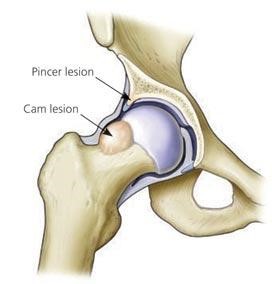There are three possible problems that cause hip compression:
– Pincer Type: If the anterior edge of the acetabulum is longer than it should be, the neck of the femur may bump and jam in here when the hip is bent. It is more common in middle-aged women.
-Cam Type: Normally the sphere-like shape of the femoral head, if it is not smooth; so, it has abnormal protrusions, the head is trapped on the edge of socket in hip bending movements such as tying shoes or pedalling. It is more common in young men.
-Mix Type: There may be problems in both pelvis and thigh. In many cases, these two forms occur together.
There are other problems that can cause hip compression. In Legg-Calve-Perthes disease, the femoral head is not sufficiently fed due to circulatory problems and bone tissue dies. Bone deformity occurs. The epiphyseal shift of the femoral head is a condition characterized by the separation of the femoral head from the growth cartilage during adolescence. “Coxa vara is characterized by decreased femoral neck angle as a result of working at different rates of femur cartilage growing is another cause of hip compression syndrome.


